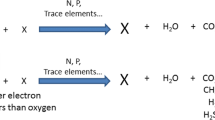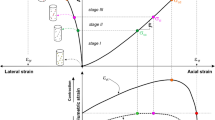Abstract
A critical assessment of the use of a variable-order, power-law type surface reaction rate equation to correlate biosorption kinetics is presented. The general nth order rate equation with three adjustable parameters was fit to the kinetic data of lead uptake by inactivated cells of Rhodotorula glutinis using a genetic algorithm search method. The uptake process was fast, with apparent equilibrium reached in approximately 30 min. According to the Akaike information criterion test, the three-parameter nth order equation was superior to the much used pseudo second order equation with two fitting parameters. However, the strong fit of the former equation resulted in unrealistic parameter estimates. Parametric sensitivity analysis indicated that the available kinetic data with only limited information content did not allow simultaneous identification of three unknown parameters. As a result, the three-parameter nth order equation was found to be overparameterized with highly correlated parameters. It was, however, possible to retrieve meaningful parameter estimates from the kinetic data when the number of fitting parameters was reduced from 3 to 2.





Similar content being viewed by others
References
Anderson-Sprecher R (1994) Model comparisons and R 2. Am Stat 48:113–117
Bai J, Yao H, Fan F, Lin M, Zhang L, Ding H, Lei F, Wu X, Li X, Guo J, Qin Z (2010) Biosorption of uranium by chemically modified Rhodotorula glutinis. J Environ Radioact 101:969–973
Blanchard G, Maunaye M, Martin G (1984) Removal of heavy metals from waters by means of natural zeolites. Water Res 18:1501–1507
Bolster CH, Hornberger GM (2007) On the use of linearized Langmuir equations. Soil Sci Soc Am J 71:1796–1806
Brouers F, Sotolongo-Costa O (2006) Generalized fractal kinetics in complex systems (application to biophysics and biotechnology). Phys A 368:165–175
Burnham KP, Anderson DR (2002) Model selection and multimodel inference: a practical information-theoretic approach, 2nd edn. Springer, New York
Cho DH, Kim EY (2003) Characterization of Pb2+ biosorption from aqueous solution by Rhodotorula glutinis. Bioprocess Biosyst Eng 25:271–277
Cho DH, Chu KH, Kim EY (2011a) Loss of cell components during rehydration of dried Rhodotorula glutinis and its implications for lead uptake. Eng Life Sci 11:283–290
Cho DH, Chu KH, Kim EY (2011b) Lead uptake and potentiometric titration studies with live and dried cells of Rhodotorula glutinis. World J Microbiol Biotechnol 27:1911–1917
Chu KH, Feng X, Kim EY, Hung Y-T (2011a) Biosorption parameter estimation with genetic algorithm. Water 3:177–195
Chu KH, Kim EY, Feng X (2011b) Batch kinetics of metal biosorption: application of the Bohart–Adams rate law. Sep Sci Technol 46:1591–1601
Haerifar M, Azizian S (2013) Mixed surface reaction and diffusion-controlled kinetic model for adsorption at the solid/solution interface. J Phys Chem C 117:8310–8317
Ho Y-S (2006) Review of second-order models for adsorption systems. J Hazard Mater B136:681–689
Kumar KV (2006) A note on the comments by Dr. Y.S. Ho on “Nitrate removal from aqueous solution by adsorption onto various materials”. J Hazard Mater B136:995–996
Lang W, Buranaboripan W, Wongchawalit J, Parakulsuksatid P, Vanichsriratana W, Sakairi N, Pathom-aree W, Sirisansaneeyakul S (2013) Biosorption of lead from acid solution using chitosan as a supporting material for spore forming-fungal biomass encapsulation. Int J Environ Sci Technol 10:579–590
Liu Y, Shen L (2008a) From Langmuir kinetics to first- and second-order rate equations for adsorption. Langmuir 24:11625–11630
Liu Y, Shen L (2008b) A general rate law equation for biosorption. Biochem Eng J 38:390–394
Liu Y, Wang Z-W (2008) Uncertainty of preset-order kinetic equations in description of biosorption data. Bioresour Technol 99:3309–3312
McCuen RH, Surbeck CQ (2008) An alternative to specious linearization of environmental models. Water Res 42:4033–4040
Morais WA, Fernandes ALP, Dantas TNC, Pereira MR, Fonseca JLC (2007) Sorption studies of a model anionic dye on crosslinked chitosan. Colloids Surf A: Physicochem Eng Asp 310:20–31
Motulsky H, Christopoulos A (2004) Fitting models to biological data using linear and nonlinear regression: a practical guide to curve fitting. Oxford University Press, Oxford
Naja G, Volesky B (2011) The mechanism of metal cation and anion biosorption. In: Kotrba P, Mackova M, Macek T (eds) Microbial biosorption of metals. Springer, Dordrecht, pp 19–58
Özer A (2007) Removal of Pb(II) ions from aqueous solutions by sulphuric acid-treated wheat bran. J Hazard Mater 141:753–761
Park D, Yun Y-S, Park JM (2010) The past, present, and future trends of biosorption. Biotechnol Bioprocess Eng 15:86–102
Pipíška M, Horník M, Remenárová L, Augustín J, Lesný J (2010) Biosorption of cadmium, cobalt and zinc by moss Rhytidiadelphus squarrosus in the single and binary component systems. Acta Chim Slov 57:163–172
Plazinski W, Rudzinski W, Plazinska A (2009) Theoretical models of sorption kinetics including a surface reaction mechanism: a review. Adv Colloid Interface Sci 152:2–13
Praus P, Turicová M (2007) A physico-chemical study of the cationic surfactants adsorption on montmorillonite. J Braz Chem Soc 18:378–383
Qiu H, Lv L, Pan B-C, Zhang Q-J, Zhang W-M, Zhang Q-X (2009) Critical review in adsorption kinetic models. J Zhejiang Univ Sci A 10:716–724
Saltelli A, Ratto M, Andres T, Campolongo F, Cariboni J, Gatelli D, Saisana M, Tarantola S (2008) Global sensitivity analysis: the primer. Wiley, Chichester
Suazo-Madrid A, Morales-Barrera L, Aranda-García E, Cristiani-Urbina E (2011) Nickel(II) biosorption by Rhodotorula glutinis. J Ind Microbiol Biotechnol 38:51–64
Usunoff E, Winzettel P, Dietrich S (2009) Sorption of fluoride by quartz sand: batch tests. Geoacta 34:9–17
Volesky B, Naja G (2007) Biosorption technology: starting up an enterprise. Int J Technol Transf Commer 6:196–211
Zamani AA, Shokri R, Yaftian MR, Parizanganeh AH (2013) Adsorption of lead, zinc and cadmium ions from contaminated water onto Peganum harmala seeds as biosorbent. Int J Environ Sci Technol 10:93–102
Acknowledgments
K.H.C. acknowledges partial support from the State Key Laboratory of Heavy Oil Processing at China University of Petroleum through the Open Project Funding Program under Agreement No. 2012-1-01.
Author information
Authors and Affiliations
Corresponding author
Nomenclature
- C i
-
Initial solution phase concentration (mg/L)
- j
-
Index
- k 2
-
Pseudo second order rate coefficient (g/mg min)
- k n
-
nth order rate coefficient [(mg/g)1−n/min]
- m
-
Number of observations
- n
-
Surface reaction order
- p
-
Parameter value
- q
-
Biosorbent phase concentration (mg/g)
- q cal,j
-
Model-calculated q value for observation j (mg/g)
- q e
-
Equilibrium biosorbent phase concentration (mg/g)
- q exp,j
-
Measured q value for observation j (mg/g)
- q max
-
Observed maximum q value (mg/g)
- \(\bar{q}_{ \exp }\)
-
Average of measured q values (mg/g)
- S p
-
Dimensionless sensitivity coefficient
- t
-
Time (min)
- w
-
Number of adjustable parameters
Rights and permissions
About this article
Cite this article
Cho, D.H., Chu, K.H. & Kim, E.Y. A critical assessment of the use of a surface reaction rate equation to correlate biosorption kinetics. Int. J. Environ. Sci. Technol. 12, 2025–2034 (2015). https://doi.org/10.1007/s13762-014-0590-3
Received:
Revised:
Accepted:
Published:
Issue Date:
DOI: https://doi.org/10.1007/s13762-014-0590-3




